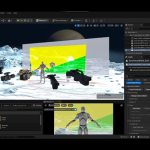As the need for elevated visual effects in media continues to surge, virtual production offers the way to satisfy this demand.
In recent years, the entertainment production industry has been abuzz with the latest trend – virtual production, also known as volumetric LED studio production or XR production. This innovative technique revolutionises the way movies, TV shows and other forms of media are created by using real-time rendering to generate immersive virtual environments for live-action filming. And while major studios, production companies and filmmakers worldwide have readily embraced this cutting-edge technology, its adoption in the Arab world has been comparatively slow.
This can be attributed to the novelty of the technology, which demands significant investment in hardware, software and personnel training, as well as the limited number of high-end feature films and TV series productions in our region. Nevertheless, there is a growing interest in employing virtual production techniques in the region, as many film and TV studios in the GCC are racing to announce their XR/volumetric LED studios and sound stages.
Virtual production has the potential to offer significant benefits to the Arab world, given its rich cultural heritage and unique environments that can be used to create visually stunning content. Filmmakers in the region can develop highly immersive and elaborate worlds that showcase the region’s architecture, landscapes and culture, which in turn can attract global audiences.
Will we see virtual production in other than a few movie productions? I cannot but remember the 3D buzzword of 2010, when it was promoted that all movies will be produced in stereoscopic 3D, and this obviously never happened. Is it different this time?
It is improbable that virtual production will gain widespread prevalence any time soon. Like many new technologies and trends in the entertainment industry, it may experience periods of hype and excitement followed by slower or more limited adoption in the long run. Nonetheless, virtual production should be viewed as a set of techniques and approaches that can be applied in various ways to fulfil the specific needs and objectives of a production. Unlike stereoscopic 3D, which required audiences to wear special glasses and created logistical challenges for theatres, virtual production can be seamlessly integrated into existing production workflows, making it more practical and easier to adopt.
While it is doubtful that all movies and TV shows will transition to virtual production, we can anticipate its greater adoption as its benefits become more widely recognised, including for smaller-scale productions such as commercials, music videos and broadcast TV. Traditional production methods will always have a place, and many productions will use a combination of virtual and traditional techniques. Virtual production should be regarded as a powerful tool to enhance and complement the traditional production process.
Virtual production technology has made significant strides recently, with success in fields such as science fiction and fantasy genres that necessitate the creation of highly detailed and fantastical environments too difficult or expensive to achieve with traditional production methods. However, there are still limitations to the level of detail that can be created, especially in highly realistic scenes. These cannot always be achieved in virtual environments, and some shots that require complex camera movements or intricate choreography may be more challenging to execute. Virtual production often requires more pre-planning and coordination to ensure that the virtual elements match up with the live-action footage.
Apart from the creative and production process considerations and the expensive investment in technology, which could be a barrier for smaller studios or productions with limited budgets, a significant challenge is the need for new skill-sets and expertise throughout the production process. Virtual production necessitates a profound understanding of CGI, real-time rendering and virtual environments, which are distinct from traditional production methods. The availability of highly skilled visual effects artists and technicians is absolutely critical.
Virtual production will occupy a central position in film and television production. Ongoing advances in technology, coupled with the successful application of virtual production techniques in industries such as gaming and architecture, are poised to make this method more attainable, thereby driving its proliferation. As the need for elevated visual effects in media continues to surge, virtual production offers the way to satisfy this demand while simultaneously streamlining the production process, saving valuable time and resources.
By Hasan R. Sayed Hasan, who is Managing Director of Master Media.

















































































